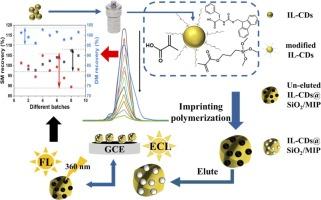Preparation of molecularly imprinted silica-wrapped ionic liquid-regulated carbon quantum dots and its application in the electroluminescence and fluorescence dual-mode detection of ochratoxin A
IF 3.7
1区 化学
Q1 CHEMISTRY, ANALYTICAL
引用次数: 0
Abstract
Ochratoxin A (OTA) is a highly harmful substance, and its sensitive and accurate detection in foods is quite important. Herein, an electrochemiluminescence (ECL)/fluorescence dual-mode sensor based on surface molecular imprinting on silica-wrapped ionic liquid-modified carbon dots (IL-CDs) is fabricated for OTA detection. In this case, the molecularly imprinted layer is prepared by chemical polymerization, and it not only acts as an identification unit but also protects the CDs. The ionic liquid 1-aminopropyl-3-methylimidazolium bis((trifluoromethyl)sulfonyl)imide is introduced in the synthesis of CDs as a surface modifier, which significantly enhances the density of secondary amine on the surface of CDs and the ECL intensity. The obtained nanoparticles show very low cytotoxicity and can produce strong ECL signal in the presence of coreactant tripropylamine and fluorescence signal under 360 nm light excitation. When the system is used for the detection of OTA, it displays high sensitivity, reproducibility and stability. Through dual-mode correction, the relative standard deviation decreases obviously and the recoveries become more satisfactory as 97.9∼102 % in detecting OTA in white wine, beer and peanut oil samples. Accordingly, this work provides a promising option for the accurate and rapid detection of OTA.

分子印迹二氧化硅包裹离子液体调控碳量子点的制备及其在赭曲霉毒素A电致发光和荧光双模检测中的应用
赭曲霉毒素A (Ochratoxin A, OTA)是一种高度有害的物质,对其进行灵敏、准确的检测具有十分重要的意义。本文制备了一种基于二氧化硅包裹离子液体修饰碳点(IL-CDs)表面分子印迹的电化学发光/荧光双模传感器,用于OTA检测。在这种情况下,分子印迹层是通过化学聚合制备的,它不仅作为识别单元,而且保护cd。将离子液体1-氨基丙基-3-甲基咪唑双((三氟甲基)磺酰)亚胺作为表面改性剂引入CDs合成中,可显著提高CDs表面仲胺的密度和ECL强度。所制得的纳米颗粒具有很低的细胞毒性,在共反应物三丙胺存在下可产生较强的ECL信号,在360 nm光激发下可产生荧光信号。该系统用于OTA检测时,具有较高的灵敏度、重现性和稳定性。通过双模校正,白葡萄酒、啤酒和花生油样品中OTA的检测相对标准偏差明显减小,回收率为97.9%~102%,令人满意。因此,本研究为准确、快速地检测OTA提供了一个有希望的选择。
本文章由计算机程序翻译,如有差异,请以英文原文为准。
求助全文
约1分钟内获得全文
求助全文
来源期刊

Sensors and Actuators B: Chemical
工程技术-电化学
CiteScore
14.60
自引率
11.90%
发文量
1776
审稿时长
3.2 months
期刊介绍:
Sensors & Actuators, B: Chemical is an international journal focused on the research and development of chemical transducers. It covers chemical sensors and biosensors, chemical actuators, and analytical microsystems. The journal is interdisciplinary, aiming to publish original works showcasing substantial advancements beyond the current state of the art in these fields, with practical applicability to solving meaningful analytical problems. Review articles are accepted by invitation from an Editor of the journal.
 求助内容:
求助内容: 应助结果提醒方式:
应助结果提醒方式:


